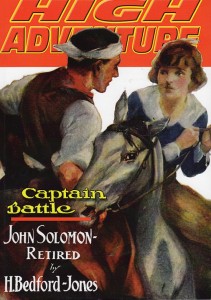Magazine Review: High Adventure #144 Captain Battle edited by John P. Gunnison
This issue of the pulp reprint magazine has two stories by renowned adventure writer H. Bedford-Jones, both from the pages of People’s. People’s was a Street & Smith publication that ran from 1906 to 1924 under varying titles, all of which had “People’s” in them. It appears to have been a generic adventure story magazine, and notable for covers that were more picturesque than lurid, unlike many of the later pulps.
“Captain Battle” has a main character whose name is both more and less unlikely at the same time. His birth name is Captain Cathenach, the family one being an old Gaelic term for “battle.” He’s investigating rum-running and other criminal activity in the Pacific Northwest towards the end of World War One. The main villain of the story is “Yellow” Hearne, a criminal mastermind who has decided to get out of the rum-running business just as Prohibition is making it really profitable as he has even bigger plans.
What brings these men into direct conflict is that they both have an acquaintance with wealthy businessman Philip Nichols…and his beautiful daughter Faith. Hearne wants to marry Faith, by hook or by crook, but would prefer she do it voluntarily, and as long as the manly Captain is around, that’s too much competition. Hearne uses the implication that he is a government agent several times in the story to get his way.
Captain Cathenach is also in love with Faith, but has a number of secrets that get in the way. First, he is actually a government agent undercover as a wealthy eccentric. Second, under another name, he’s wanted for jewel robbery and murder. Those he could probably clear up for Faith, but his third secret, the one that keeps him from revealing his true feelings to the maiden, is that he’s going blind!
There are a number of twists and turns, including a mid-story shocker when Cathenach gets a head wound and becomes a simple-minded amnesiac.
There’s some period racism in the story, with Cathenach being of the “my best friend is Chinese” type. Sexism is more of the setting related type; Faith is plucky, but not expected to fend for herself in dangerous situations.
“John Solomon-Retired” is another long story, this one featuring recurring character John Solomon, a Cockney ship’s chandler (a dealer in ship supplies and equipment.) The hero of the story is Ralph Carter, an American salesman who finds himself at loose ends in Java. Mr. Solomon enlists Ralph in a favor the older man is doing a Chinese secret society.
It seems that Miss Wilhemina Bergen owns a spice plantation that hasn’t been able to sell its crop due to the Great War sapping trade. Herman Stoppel, a “half-caste” (mixed race) trader, has been trying to gain control of the plantation for some reason as yet unknown. Wing Fu, the secret society representative, went to college with Miss Bergen’s late brother, and has determined that Captain Stoppel thinks he can make two million American dollars from something on the plantation. It’s unlikely to be the nutmeg, even if the American market is in dire need.
Mr. Carter is sent to the plantation to pretend to be a rival potential buyer, to see if he can figure out what’s going on and protect Miss Bergen’s interests.
Once again there are many twists to the story, with much of the later action taking place on John Solomon’s tricked-out ship, and then on Stoppel’s own craft. There’s a series of plans and reversals until the final paragraphs.
Again, some period racism, though meaner to the mixed race people than to the Chinese person. Miss Bergen has competence in her background, she’s been running the plantation for the last two years since her brother died, but has no action skills. Stoppel turns out to want to marry Miss Bergen–and not to gain the money, either! She is pretty racist in her response to that.
Both are exciting adventure stories with plenty of action and a bit of romance (somewhat more believable in the first story as the characters have known each other for some years.) They are, however, products of their time and this may not appeal to some readers.

